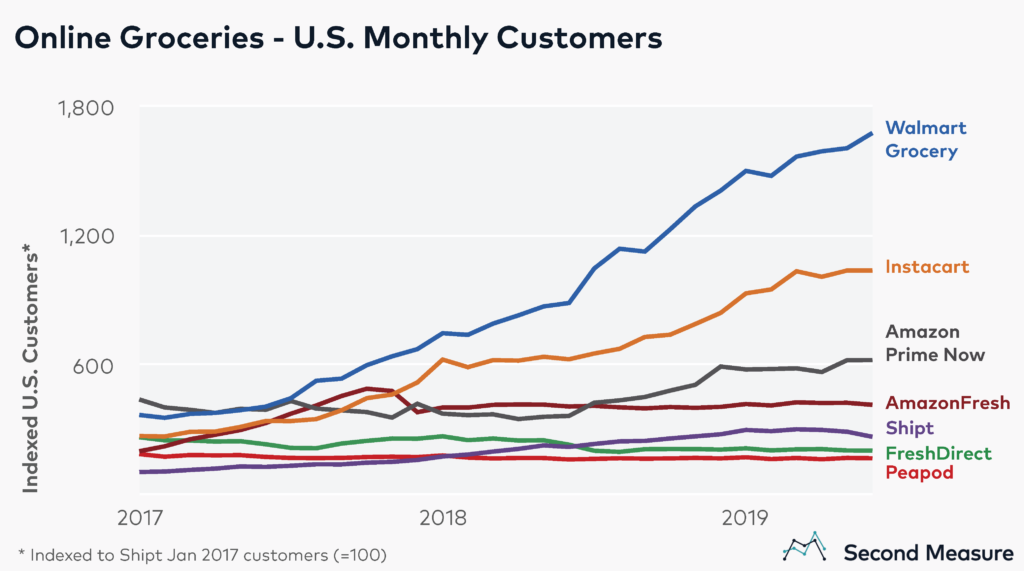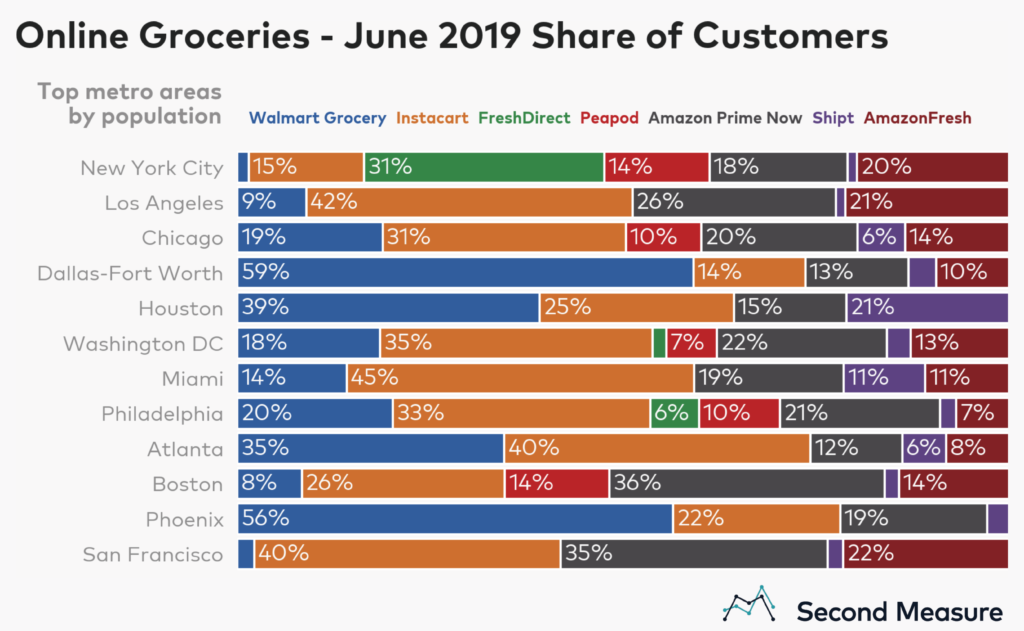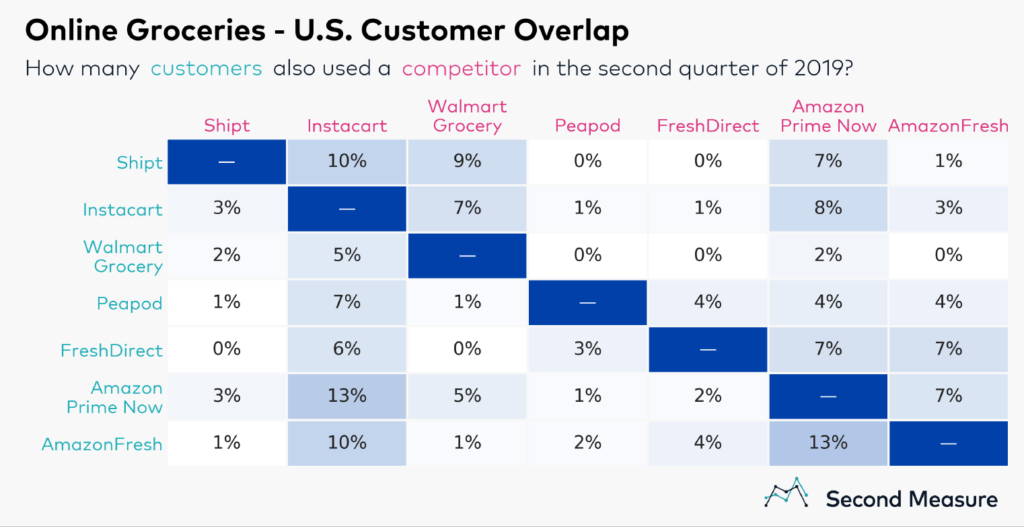NOTE: Bloomberg Second Measure launched a new and exclusive transaction dataset in July 2022. Our data continues to be broadly representative of U.S. consumers. As a result of this panel change, however, we recommend using only the latest posts in assessing metrics, and do not support referring to historical blog posts to infer period-over-period comparisons.
When Americans think of grocery pickup and delivery services, they often think of gig-economy upstarts like Instacart or Shipt. These companies are popular and growing, but neither is No. 1 when it comes to online supermarket shopping. In fact, it’s a long-established retailer wearing that crown: Walmart Grocery.
Walmart Grocery, which operates in nearly every U.S. state, had 62 percent more customers in June than its nearest competitor, Instacart, which also operates nationwide. Walmart Grocery customers include users of both its pickup and delivery services. The same is true of Instacart, Amazon Prime Now, and Peapod. Shipt and FreshDirect offer only delivery, and AmazonFresh offers delivery, plus pickup in Seattle.

Walmart rival, Target, purchased grocery delivery company Shipt in December 2017, and Shipt’s customers have increased by 69 percent since then. Shipt requires customers to buy an annual or monthly membership to get deliveries from the many grocers it works with, but Target deliveries are now available without a subscription. Second Measure cannot distinguish Shipt sales that originate in the Target app or on Target.com, so the company’s relative customer counts may be even higher than our analysis shows.
Instacart not hurt by split with Whole Foods
There was much hand wringing over the December 2018 announcement that Amazon-owned Whole Foods Market would cut ties with longtime delivery partner, Instacart. Whole Foods was one of Instacart’s first and, at one time, largest partners. But, today, Instacart reportedly delivers for 20,000 stores in the U.S. and Canada and claims Whole Foods was responsible for just 5 percent of recent sales. When the relationship finally ended in May 2019, Instacart barely noticed. In fact, the company had 23 percent more customers in June than it had when it announced the breakup in December.
Amazon battles itself in grocery delivery
Amazon operates two of the online grocery services in our analysis: Amazon Prime Now and AmazonFresh. The former is on the rise while the latter—and older brand—is one of the few grocery delivery services in decline.
Founded more than a decade ago, AmazonFresh delivers groceries from Amazon warehouses, but it never really caught its stride. It now operates in just 15 U.S. cities and has closed operations in others. In June, its sales were down 19 percent year-over-year—the worst sales change in our report.
In contrast, Amazon Prime Now, saw year-over-year sales nearly triple in June—the highest growth in the analysis. The brand delivers select Amazon items in two hours or less. It added Whole Foods groceries to its offerings in February 2018 and heavily markets Whole Foods on the Prime Now homepage. Prime Now operates in 90 U.S. cities, and the service is included with the regular Amazon Prime membership fee, $119 annually. AmazonFresh requires customers to pay an additional $14.99 per month on top of their Prime memberships.
Prime Now received some of the highest marks in a recent Consumer Reports ranking of grocery delivery services, and Amazon Fresh received some of the lowest.
FreshDirect is big in New York; market leader Walmart isn’t
Like restaurant meal delivery brands, companies in this industry have strongholds in different regions. Peapod and FreshDirect each operate in just a few, mostly Northeastern states. Each commands less than 5 percent of the national market’s customers. But FreshDirect is a giant in the nation’s most populated metro area, where it is headquartered. It captures 31 percent of customers in the New York City region—the highest share of any company there. (In our analysis, customers are counted at each company they use, so a customer who shops with more than one service will be counted more than once.)

The national leader, Walmart Grocery, claims less than 2 percent of the New York metro area’s customers. It also has single-digit shares of shoppers in the metro areas of San Francisco (2 percent), Boston (8 percent) and Los Angeles (9 percent). It’s a much different story in Phoenix and Dallas. In both metros, the nation’s biggest retailer wrangles more than half of all online grocery customers.
Online grocery shoppers are loyal
Most Americans regularly shop at just one or two grocery stores, so it’s not surprising that most online grocery shoppers also stick with their favorite service. This is in contrast to the meal delivery industry, where diners frequently hop between apps to get the broadest selection of restaurants.
With the exception of Instacart, no grocery delivery company shared more than 9 percent of another company’s customers in the second quarter of 2019.

The good news for grocery delivery brands is that their industry—full of loyal customers—is expanding. And there’s still lots of room to grow. Twelve percent of U.S. consumers have tried one of the grocery delivery services in our analysis, up from 9 percent in June 2018.
*Note: Second Measure regularly refreshes its panel and methods in order to provide the highest quality data that is broadly representative of U.S. consumers. As a result, we may restate historical data, including our blog content.
